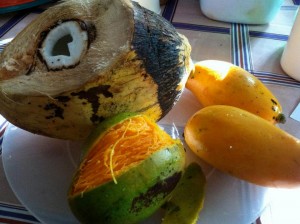
This winter, I had the opportunity to travel to Haiti with my sister and grandfather to visit family members and learn firsthand about the rich Haitian culture. While there, I picked up on a few healthy lifestyle habits that we can implement no matter where we are.
1. Start your day with a morning exercise
My grandfather led the family in a 15-minute daily exercise before breakfast—nothing intense, just some simple exercises such as jogging in place, warming up and stretching the arm, leg and core muscles. I added some jumping jacks and squats for a rapid energy boost! But be sure to drink water before and after your routine.
2. Lunch as the biggest meal

This gives our body ample time to digest our food before hitting the bed and gives us enough time to burn off excess calories from the meal. For dinner, use a small plate and avoid heavy starches such as rice and potatoes.
3. No beverages during the meal
“Eat, wait 30 minutes, then drink water.” My grandfather constantly reminds me of this in his thick Haitian accent. But why? Most of us have a glass of water on the far right-hand side of our plate at every meal. Is there something wrong with this?
It’s a good idea to drink water 30 minutes before and after a meal, but not during the meal itself. For proper digestion, our body makes digestive juices that help breakdown food. Drinking water with our meal will dilute these essential fluids, making it harder for our body to digest the foods. With that being said, water is important in the digestion process, as the stomach, liver and kidneys depend on water to break down the nutrients and allocate it to its proper place in the body. So we have to keep our body hydrated by drinking fluids throughout the day, but not during our meals.

4. Snacks: fresh fruits
Between meals, my family in Haiti served us fruit after fruit! Although we can’t all pick fresh mangoes off the tree, add fruits to your day by making smoothies, adding it to yogurt or cereal, or eating it whole!

5. Buy local produce and meats
Street vendors were common on the streets of Haiti, and that’s where my family bought most of their produce. Purchasing produce from local farmers markets can help avoid pesticides and ensure natural sweetness.
6. Add fish to your diet
Fish was a big part of the Haitian diet, filling us with calcium, omega-3s (healthy fats), protein, and vitamins and minerals that can help decrease blood pressure and reduce the risk of heart attack or stroke.
Fish was used in many various forms, including in casseroles and pasta. Chunks of fresh fish were thrown into our pasta for breakfast! Try adding fish to your meals twice a week!
Haitians tend to eat lots of natural and minimally processed foods. They keep their meals simple, and so should we!





